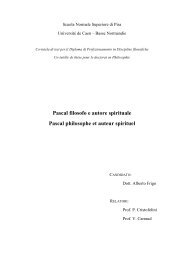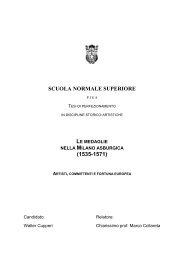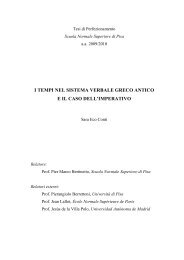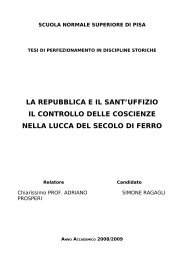CATULLUS 68 - Scuola Normale Superiore
CATULLUS 68 - Scuola Normale Superiore
CATULLUS 68 - Scuola Normale Superiore
Create successful ePaper yourself
Turn your PDF publications into a flip-book with our unique Google optimized e-Paper software.
valley as if it were a slope than that de prono … colle or de prona … Alpe should have yielded de prona …<br />
ualle. The alliteration in ualle uolutus also speaks against emendation.<br />
prona praeceps pronus ‘heading down’, ‘facing downward’ is attested from this period onwards (thus TLL<br />
10.2.1930.33-35) in Varro (5x), in Cicero’s philosophical writings (4x), in Lucretius (2x) and in Catullus (7x,<br />
also at 17.23, 62.51, 64.40, 109 and 313 and 65.23: note its concentration in the long poems). It is a vigorous<br />
word, witness passages such as 64.108f. illa procul radicitus exturbata / prona cadit, late quaeuis cumque<br />
obuia frangens.<br />
praeceps ‘headlong’, ‘precipitate’, on the other hand, is ancient: found in Plautus (4x), Terence (4x), Cato<br />
the Elder (1-2x Agr.) and also in Ennius (Ann. 390 Skutsch praecipe casu ‘in a headlong fall’). Catullus uses<br />
the word also at 17.9, 40.2, 64.244, 65.23 and 105.2, to characterize a major fall or jump.<br />
Here these two words express by their sound as much as by their meaning the speed of the mountain torrent.<br />
They are juxtaposed in a similar way and in the same metrical position in 65.23 atque illud prono praeceps<br />
agitur decursu (not of a mountain stream but just of an apple rolling down a girl’s lap).<br />
est … uolutus ‘It has rolled on’, a passive used in the middle sense: compare Verg. Geo. 3.522f. per saxa<br />
uolutus … amnis and Aen. 6.659 plurimus Eridanus per siluam uoluitur amnis, Hor. Od. 4.14.25 sic<br />
tauriformis uoluitur Aufidus and Ov. Met. 1.282 defrenato uoluuntur in aequora cursu (i.e. amnes).<br />
60 A difficult verse. The MSS write per medium densi transit iter populi, which one can try to interpret in a<br />
variety of ways:<br />
(i) ‘it makes its way (transit iter) through the middle of a dense crowd of people’ – here<br />
transit is taken to be transitive, its subject is qui in the previous line and its object is iter;<br />
(iia) ‘it crosses (transit) the middle of the path (per medium … iter) of a dense crowd of<br />
people’ – here transit is intransitive, its subject is qui in the previous line and iter goes<br />
with medium;<br />
(iib) ‘it passes by (transit) the middle of the path (per medium … iter) of a dense crowd of<br />
people’ – here the construction is the same as in (iia), but transit is given a different<br />
interpretation;<br />
(iii) ‘its course (iter) passes (transit) through the middle of a dense crowd of people’ – here<br />
transit is intransitive and its subject is iter.<br />
Interpretation (i) is preferred by Huschke (1792: 93-95) and Haupt (1837: 87-89), and according to Ellis also<br />
by Weise; (iia) is preferred by Ellis, Riese, Kroll and Fordyce; (iib) was proposed by Baehrens; (iii) occurred<br />
to me as a possibility.<br />
Interpretation (i) is problematic, first of all, because when transeo is transitive, it means ‘to cross’ a river, a<br />
strait or something similar and not (as would be required here) ‘to complete’, ‘to make’ a journey or ‘to<br />
cover’ a distance; in short, it tends to be used for movement across an obstacle and not along a given route.<br />
173






